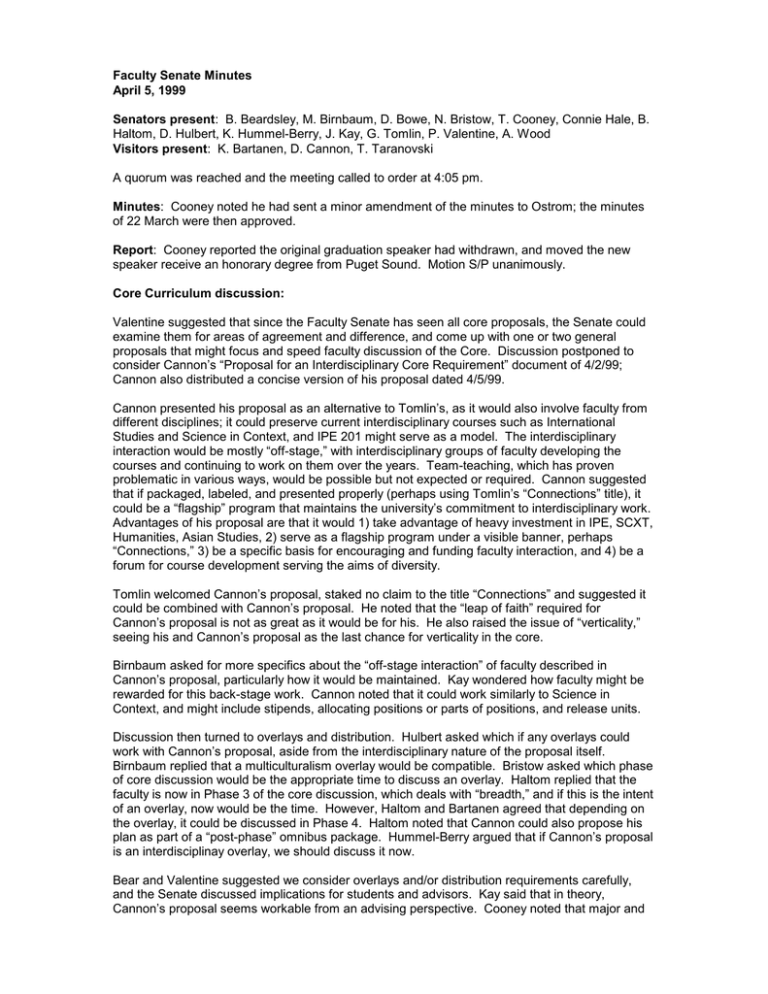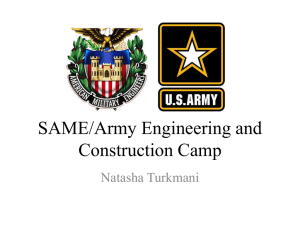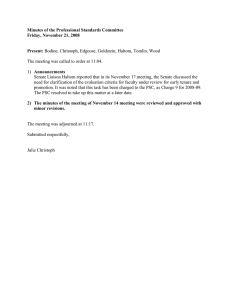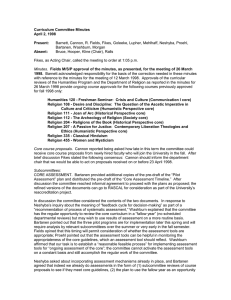Faculty Senate Minutes April 5, 1999 Senators present Visitors present
advertisement

Faculty Senate Minutes April 5, 1999 Senators present: B. Beardsley, M. Birnbaum, D. Bowe, N. Bristow, T. Cooney, Connie Hale, B. Haltom, D. Hulbert, K. Hummel-Berry, J. Kay, G. Tomlin, P. Valentine, A. Wood Visitors present: K. Bartanen, D. Cannon, T. Taranovski A quorum was reached and the meeting called to order at 4:05 pm. Minutes: Cooney noted he had sent a minor amendment of the minutes to Ostrom; the minutes of 22 March were then approved. Report: Cooney reported the original graduation speaker had withdrawn, and moved the new speaker receive an honorary degree from Puget Sound. Motion S/P unanimously. Core Curriculum discussion: Valentine suggested that since the Faculty Senate has seen all core proposals, the Senate could examine them for areas of agreement and difference, and come up with one or two general proposals that might focus and speed faculty discussion of the Core. Discussion postponed to consider Cannon’s “Proposal for an Interdisciplinary Core Requirement” document of 4/2/99; Cannon also distributed a concise version of his proposal dated 4/5/99. Cannon presented his proposal as an alternative to Tomlin’s, as it would also involve faculty from different disciplines; it could preserve current interdisciplinary courses such as International Studies and Science in Context, and IPE 201 might serve as a model. The interdisciplinary interaction would be mostly “off-stage,” with interdisciplinary groups of faculty developing the courses and continuing to work on them over the years. Team-teaching, which has proven problematic in various ways, would be possible but not expected or required. Cannon suggested that if packaged, labeled, and presented properly (perhaps using Tomlin’s “Connections” title), it could be a “flagship” program that maintains the university’s commitment to interdisciplinary work. Advantages of his proposal are that it would 1) take advantage of heavy investment in IPE, SCXT, Humanities, Asian Studies, 2) serve as a flagship program under a visible banner, perhaps “Connections,” 3) be a specific basis for encouraging and funding faculty interaction, and 4) be a forum for course development serving the aims of diversity. Tomlin welcomed Cannon’s proposal, staked no claim to the title “Connections” and suggested it could be combined with Cannon’s proposal. He noted that the “leap of faith” required for Cannon’s proposal is not as great as it would be for his. He also raised the issue of “verticality,” seeing his and Cannon’s proposal as the last chance for verticality in the core. Birnbaum asked for more specifics about the “off-stage interaction” of faculty described in Cannon’s proposal, particularly how it would be maintained. Kay wondered how faculty might be rewarded for this back-stage work. Cannon noted that it could work similarly to Science in Context, and might include stipends, allocating positions or parts of positions, and release units. Discussion then turned to overlays and distribution. Hulbert asked which if any overlays could work with Cannon’s proposal, aside from the interdisciplinary nature of the proposal itself. Birnbaum replied that a multiculturalism overlay would be compatible. Bristow asked which phase of core discussion would be the appropriate time to discuss an overlay. Haltom replied that the faculty is now in Phase 3 of the core discussion, which deals with “breadth,” and if this is the intent of an overlay, now would be the time. However, Haltom and Bartanen agreed that depending on the overlay, it could be discussed in Phase 4. Haltom noted that Cannon could also propose his plan as part of a “post-phase” omnibus package. Hummel-Berry argued that if Cannon’s proposal is an interdisciplinay overlay, we should discuss it now. Bear and Valentine suggested we consider overlays and/or distribution requirements carefully, and the Senate discussed implications for students and advisors. Kay said that in theory, Cannon’s proposal seems workable from an advising perspective. Cooney noted that major and general education requirements are usually about the same size (most of our majors require 9 or 10 units) and we need to take into account the size of some of our majors as we look at core proposals; he suggested we return to consider our objectives for the core, but that the whole faculty, not just the Senate, needs to be involved. Beardsley noted that we need to keep Faculty Senate and full faculty discussions separate, that the Senate must work in advance, but there is business on the floor. Taranovski noted other proposals have some kind of distribution requirement as well, and that Cannon’s doesn’t could be a problem. Wood asked if the faculty has sorted out whether there should be a distribution requirement; multiple voices replied “no,” that the faculty still must decide if we want a distribution requirement, and/or an overlay. Tomlin argued we need to create a matrix for faculty discussions of these issues since Robert’s Rules doesn’t facilitate this in full faculty meetings, and that while “designing by components” we must consider “designing for totality” in spite of the problems that emerged in such discussions three years ago. Valentine returned to the initial discussion by asking if the Senate, as an interdisciplinary group that has seen all proposals, might come up with two “sample” proposals for faculty consideration. While this is feasible, Bristow wondered whether faculty perceptions that the Senate’s role is to oversee process rather than content might be compromised if the Senate created these specific proposals. After a brief but spirited discussion of the faculty’s capacity for short- and long-term memories, Hulbert mentioned the recent accreditation visit and their concern with “outcomes.” Cooney reminded us that we will be held accountable for outcomes, and not just by students and faculty, but by others, in terms of what a general education should be. The meeting adjourned at 5:12. Respectfully submitted, Connie J. Hale







